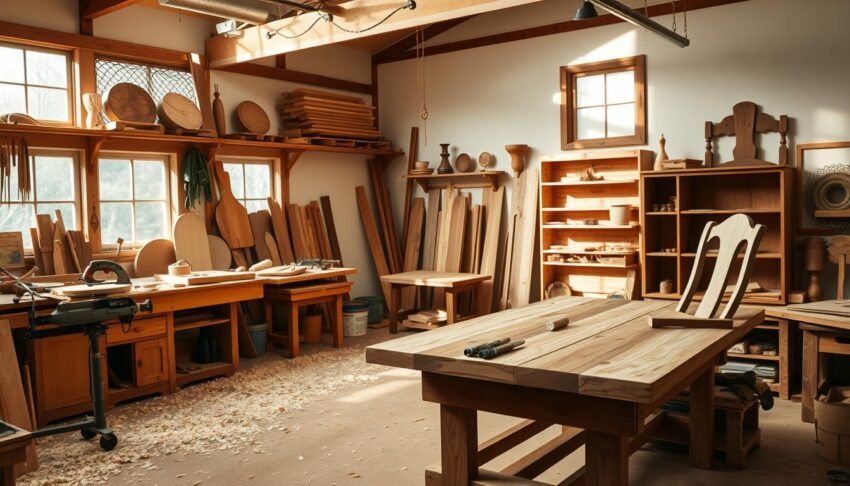Standing in my garage, I looked at the weathered wood and felt excited. Woodworking had always fascinated me. Recently, I decided to try it out. It turned into a journey of creating something real with my hands.
If you’re drawn to DIY woodworking like I was, you might dream of making something beautiful. The idea of turning raw materials into art or useful items is empowering.
In this guide, I’ll help you start your DIY woodworking journey. We’ll cover tools, materials, and techniques. Whether you’re new or have some experience, I’m here to help you achieve your goals.
Key Takeaways
- Discover the joy and satisfaction of creating your own DIY woodworking projects
- Learn essential tools, techniques, and safety practices to become a confident woodworker
- Explore a wide range of project ideas, from simple decor to functional furniture
- Develop valuable skills that can be applied to a variety of DIY endeavors
- Unlock your creative potential and transform your living space with personalized wooden pieces
Introduction to DIY Woodworking
Dive into the captivating world of DIY woodworking and unlock a realm of creative possibilities. Whether you’re a seasoned hobbyist or a curious beginner, this timeless craft offers a unique blend of skill, artistry, and personal fulfillment. Your hands shape raw wood into stunning projects, each one a testament to your growing talents.
What is DIY Woodworking?
DIY woodworking is the art of designing, constructing, and finishing wood-based projects. It uses various tools and techniques. From simple home decor items to intricate furniture pieces, the possibilities are endless. This hands-on hobby allows you to unleash your creativity, problem-solve, and develop a deep appreciation for the natural beauty of wood.
Benefits of Engaging in Woodworking
- Unleash your creativity and express your personal style
- Develop problem-solving skills and a sense of accomplishment
- Enjoy the therapeutic benefits of a hands-on, mindful activity
- Create unique, high-quality pieces for your home or as gifts
- Potentially save money by making your own furniture and decor
Common Misconceptions About Woodworking
Many people believe that DIY woodworking is complex and intimidating. However, with the right guidance and a willingness to learn, anyone can dive into this rewarding craft. From simple wood projects for beginners to more advanced woodworking techniques, the journey is filled with opportunities for growth and personal fulfillment.
“The journey of a thousand miles begins with a single step.” – Lao Tzu
By dispelling these misconceptions and embracing the accessibility of DIY woodworking, you can embark on a fulfilling journey of self-discovery. Create beautiful, functional pieces that reflect your unique style and creativity.
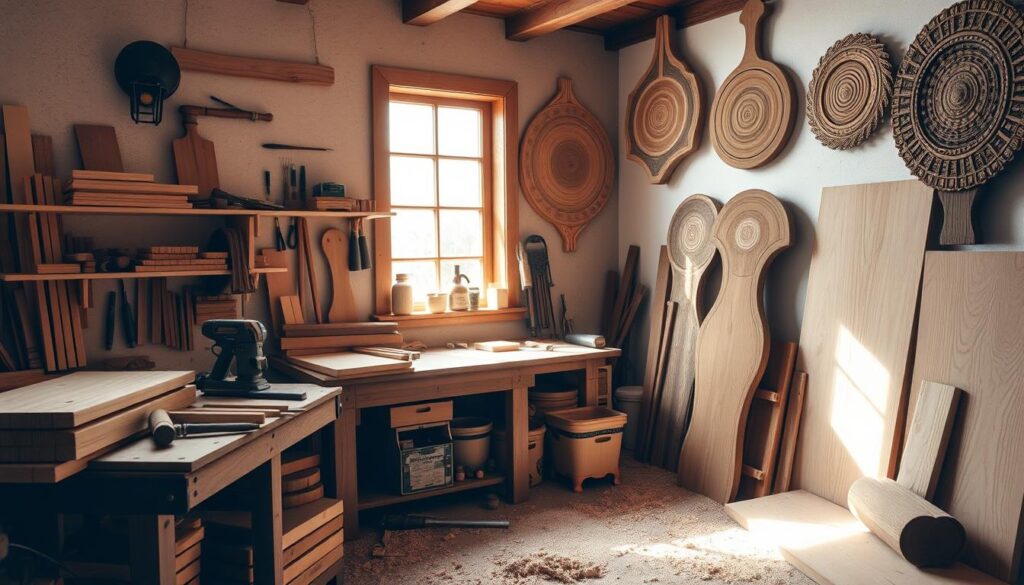
Essential Tools for Beginners
Starting your woodworking journey can be thrilling and a bit scary, especially if you’re new. The secret to making great DIY wood crafts is having the right tools. We’ll look at the key hand tools, power tools, and safety gear every beginner woodworker needs.
Must-Have Hand Tools
Power tools can make things faster, but learning with hand tools is essential. Start with the basics:
- Hammer: A versatile tool for driving nails and shaping wood.
- Chisels: Used for shaping, cutting, and finishing wood surfaces.
- Measuring Tape: Indispensable for accurate measurements and layout work.
- Adjustable Wrench: Helpful for tightening and loosening hardware.
- Sandpaper: Essential for smoothing and finishing woodworking projects.
Recommended Power Tools for Beginners
Hand tools are a good start, but power tools can make your work easier. Here are some beginner-friendly power tools to consider:
- Circular Saw: Allows for quick and precise cuts in various materials.
- Jigsaw: Ideal for making intricate and curved cuts in wood.
- Drill: Versatile for drilling holes, driving screws, and more.
- Random Orbital Sander: Efficiently smoothes surfaces and removes material.
Discover the ultimate DIY plans to transform your home today! Click here to start creating.
Safety Gear and Equipment
Woodworking is a rewarding hobby, but safety comes first. Make sure you have the following essential safety gear:
| Safety Gear | Purpose |
|---|---|
| Protective Eyewear | Shields your eyes from wood chips, dust, and debris. |
| Hearing Protection | Safeguards your hearing from the noise of power tools. |
| Dust Mask or Respirator | Filters out harmful airborne particles during woodworking. |
| Sturdy Gloves | Protects your hands from cuts, splinters, and other injuries. |
By getting the right tools and safety gear, you’ll be ready to create amazing woodworking designs and DIY wood crafts with confidence.
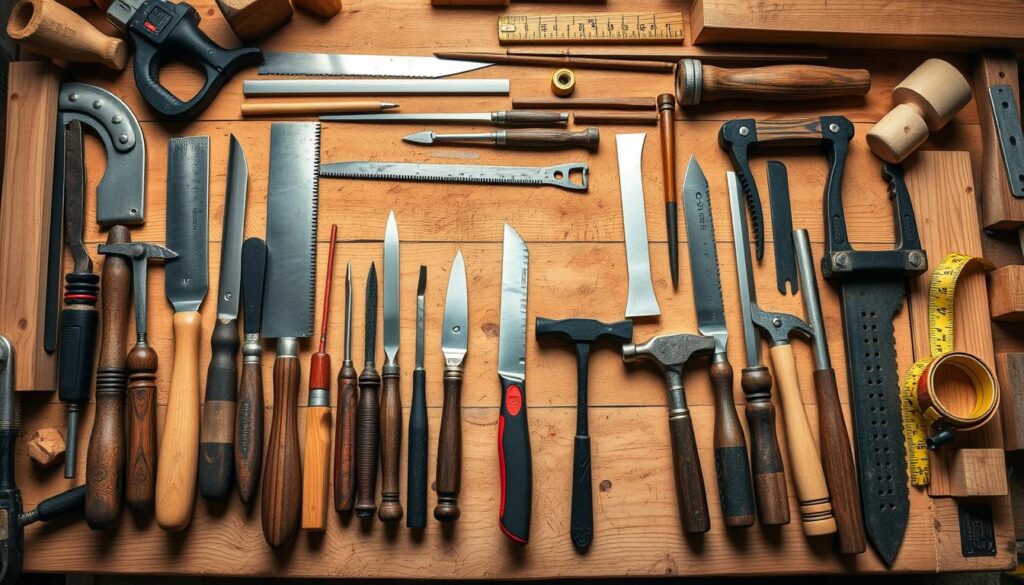
Choosing the Right Wood
Choosing the right wood is key for DIY woodworking projects. It affects the look and durability of your creations. Let’s look at different wood types, how to pick quality lumber, and environmental factors.
Types of Wood for Projects
Woodworking offers many wood species, each with its own traits. For DIY projects, you might choose:
- Softwoods like pine, cedar, and fir, which are more affordable and easy to work with.
- Hardwoods such as oak, maple, and cherry, which are durable and have a refined look.
- Exotic woods like walnut, mahogany, and teak, which add elegance and personality.
How to Select Quality Lumber
When picking wood for your woodworking plans and DIY home decor, look for quality. Avoid wood with knots, cracks, or warping. Check the grain pattern and moisture content to match your project’s needs.
| Wood Type | Typical Uses | Grain Characteristics | Moisture Content |
|---|---|---|---|
| Pine | Furniture, cabinetry, trim | Straight, even grain | 6-12% |
| Oak | Furniture, flooring, cabinetry | Prominent, unique grain pattern | 8-12% |
| Walnut | Furniture, woodturning, decorative items | Straight, sometimes wavy grain | 6-10% |
Environmental Considerations
Think about the environment when choosing wood. Opt for sustainably sourced lumber to reduce your carbon footprint. This supports eco-friendly practices and helps the DIY home decor and woodworking plans community.

Finding Simple Woodworking Plans
Starting your woodworking journey is exciting. Finding the right DIY plans is key to your success. Whether you’re new or have experience, many resources can help you find simple, beautiful woodworking blueprints.
Ready to create stunning DIY projects? Find all the plans you need here!
Sources for Free DIY Woodworking Plans
Looking for free woodworking plans online is a great first step. Sites like Pinterest, Instructables, and Woodworking for Mere Mortals have lots of plans. They range from easy projects to more complex ones. You’ll find step-by-step guides, materials lists, and videos to help you.
Tips for Modifying Existing Plans
Free plans are a good start, but you might want to make them your own. Look over the plan and think about how to change it. You can adjust sizes or add different hardware to make it unique.
Creating Your Own Plans
Being creative, try designing your own woodworking blueprints or DIY furniture plans. This lets you express your unique style and meet your exact needs. Begin by sketching your idea, measuring the space, and researching materials and techniques. Don’t hesitate to try new things and learn as you go. The joy of creating something unique is unmatched.
With many resources and the chance to modify or create your own plans, woodworking is full of possibilities. Dive into it, and let your creativity in DIY projects shine.
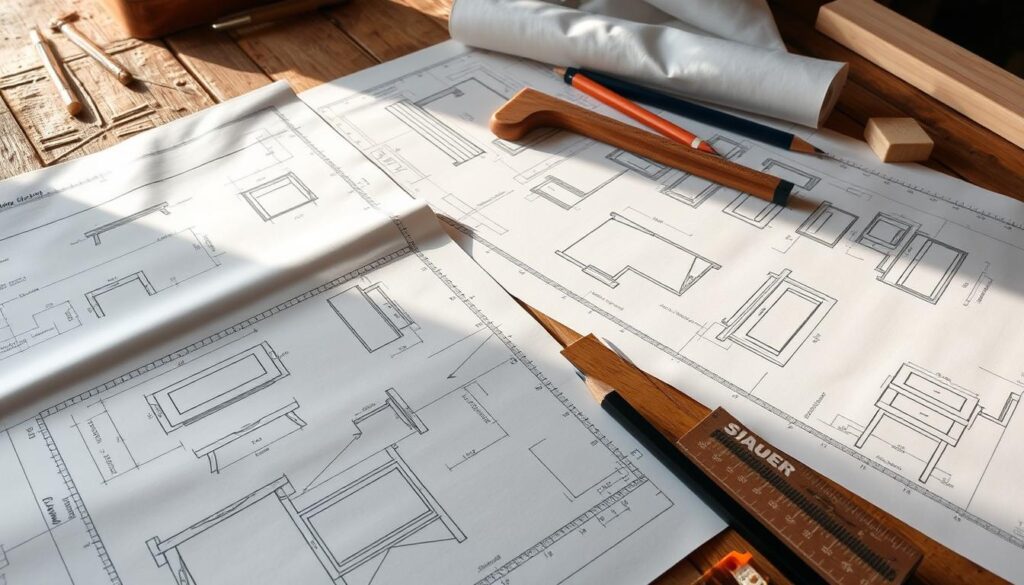
Step-by-Step DIY Woodworking Tutorials
Unleash your inner woodworking artist with our step-by-step tutorials. Learn from the basics to advanced joinery techniques. We’ll help you craft stunning DIY woodworking projects.
Basic Techniques for Beginners
Start with the basics of woodworking. Learn essential skills for your DIY projects. Our tutorials will show you:
- Measuring and marking wood accurately
- Proper use of hand tools, such as saws, chisels, and planes
- Safely operating power tools like circular saws and drill presses
- Achieving smooth, even surfaces through sanding techniques
Understanding Joinery Basics
Mastering joinery is crucial for sturdy woodworking projects. Explore our tutorials on:
- Dovetail joints for classic furniture construction
- Mortise and tenon joints for strong, visible connections
- Pocket hole joinery for quick and easy assembly
- Lap joints for seamless edge-to-edge connections
Finishing Techniques for a Professional Look
Learn to achieve a flawless finish on your woodworking tutorials and DIY woodworking projects. Our guides cover:
- Sanding techniques to create a smooth, even surface
- Staining and finishing methods for a variety of wood types
- Applying protective coatings like varnish or polyurethane
- Strategies for a consistent, blemish-free final result
Dive into our collection of woodworking tutorials and DIY woodworking guides. Unlock your creative potential and turn ordinary wood into extraordinary masterpieces.
Unlock endless DIY inspiration with easy-to-follow guides. Start your journey now
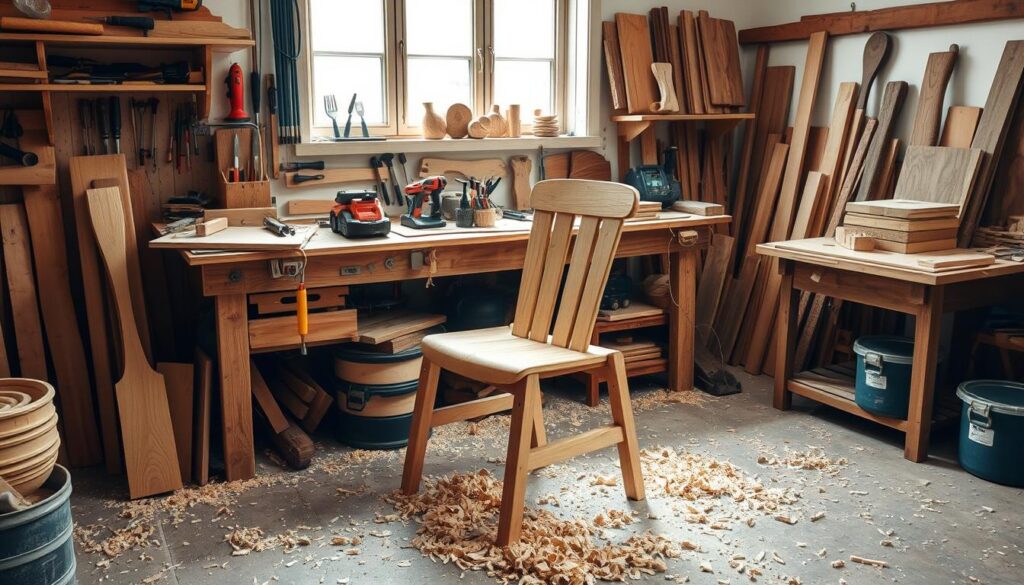
Safety Precautions in Woodworking
As a beginner woodworker, your safety is most important. Working on DIY projects means you need a safe space and to use tools wisely. By following these safety tips, you can enjoy woodworking without risks.
Workspace Safety Tips
Make your workspace clean and well-lit to avoid accidents. Keep it clutter-free and well-ventilated to manage dust. Good lighting helps prevent eye strain. Also, use anti-slip mats or flooring for a stable work area.
Safe Tool Usage
Always follow the tool’s safety guidelines and the manufacturer’s instructions. Wear safety gear like glasses, earplugs, and gloves. Keep your tools in good shape and replace any damaged parts for safe use.
First Aid Essentials
- Have a first aid kit ready in your woodworking area.
- It should have bandages, antiseptic wipes, gauze pads, and adhesive tape.
- Include emergency contact info and a list of local hospitals.
By focusing on these safety steps, you can make a safe space for your woodworking projects. This way, you can learn and create with confidence. Remember, safety is key to a rewarding DIY woodworking journey.
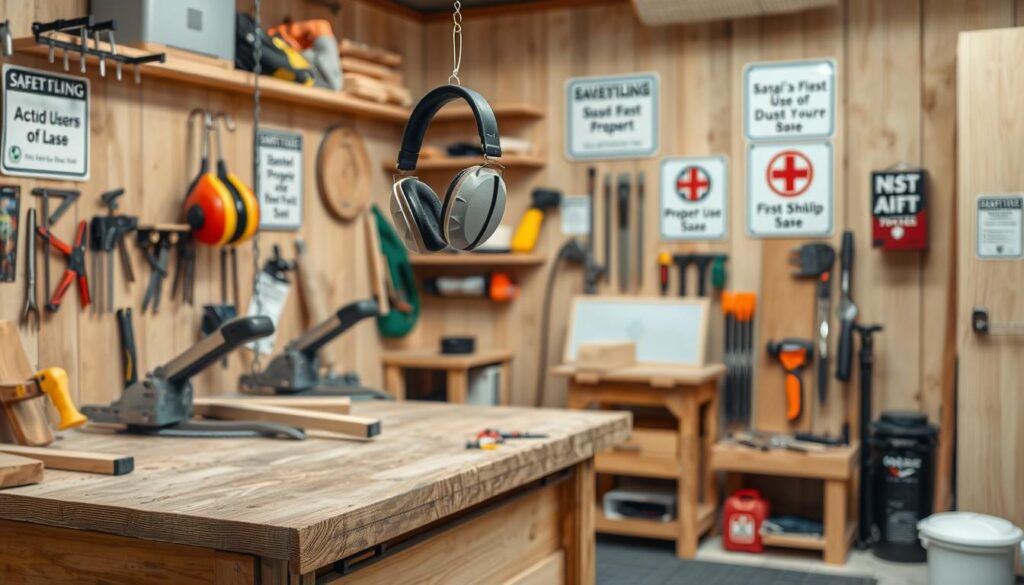
Beginners’ Woodworking Projects
Starting with DIY wood crafts and projects can be very rewarding, especially for beginners. You can make simple furniture, decorative items, or storage solutions. There are many easy projects for beginners to try and get good at.
Simple Furniture Ideas
Beginners should start with simple furniture. A DIY end table, a rustic wooden bench, or minimalist floating shelves are great for beginners. These projects need only basic tools and materials, making them perfect for newbies.
Decorative Wood Items
There are also many decorative wood items for beginners. You can make wooden wall art, handcrafted picture frames, unique wooden coasters, or custom-made wooden signs. These projects let you be creative and add a personal touch to your home.
Practical Storage Solutions
- Wooden crates and boxes
- DIY shoe racks
- Simple spice racks
- Handmade wooden organizers
Practical storage solutions are also great for beginners. You can make wooden crates, DIY shoe racks, simple spice racks, and handmade organizers. These projects help declutter and add charm to your space.
Remember, the key to success is to start small and have fun. Focus on improving your skills and enjoy the process. DIY woodworking is all about learning and experimenting, so don’t be afraid to try new things!
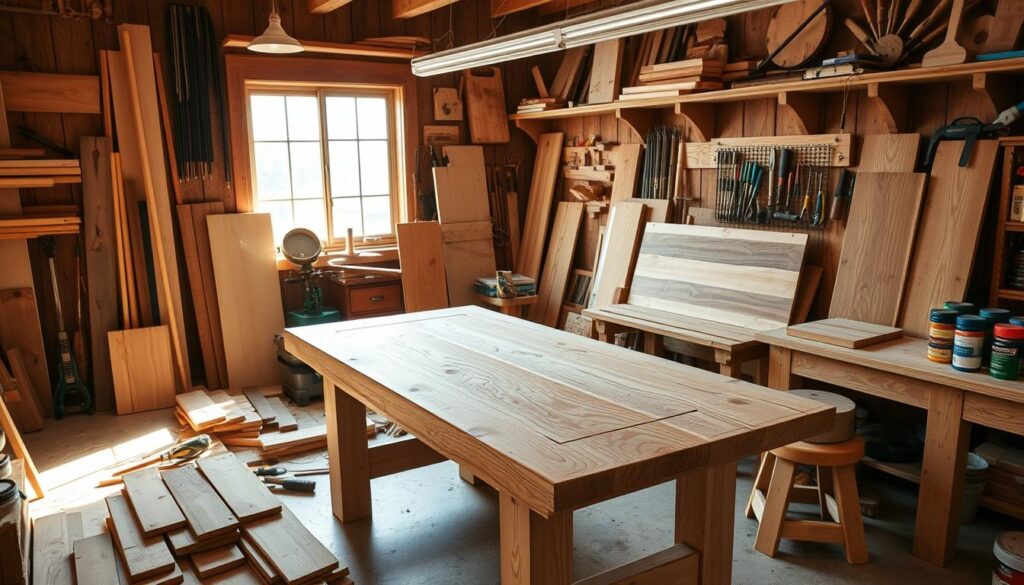
| Project | Difficulty Level | Time Required | Materials Needed |
|---|---|---|---|
| DIY End Table | Beginner | 2-4 hours | Lumber, wood glue, sandpaper, stain/paint |
| Wooden Wall Art | Intermediate | 4-6 hours | Plywood, wood stain, saws, nails/screws |
| Wooden Crates | Beginner | 1-2 hours | Plywood, wood screws, wood glue, stain/paint |
Troubleshooting Common Woodworking Problems
DIY woodworkers often face challenges. Issues like warped wood, misalignments, and sanding mishaps can pop up. It’s key to learn how to solve these problems to get great results. We’ll look at common woodworking issues and offer solutions to help you on your DIY journey.
Dealing with Warped Wood
Warped wood can be a real problem. But, there are ways to fix it. Soaking the wood in water and placing it under heavy weights can help it dry and flatten. You can also use a power planer or hand plane to remove the warped parts.
Always sand the wood well after fixing it. This ensures a smooth, even surface.
Fixing Misalignments
Woodworking needs precise measurements and careful assembly. But, sometimes things don’t fit right. To fix misalignments, check your measurements again and make sure everything fits. Use clamps or wood glue to gently adjust the pieces.
Sanding can also help fix gaps or uneven edges.
Build your dream furniture with these amazing DIY plans. Get started here
Sanding and Finishing Mistakes
- Uneven sanding can cause scratches or divots. Sand thoroughly and evenly, using finer grits of sandpaper.
- Finishing mistakes, like bubbles or drips, can mess up your project. Apply finishes in thin, even coats, letting them dry fully between layers.
- If you see issues with the finish, don’t worry. Sand it down and start again. Patience and detail are crucial for a professional finish.
Every woodworking project has its own challenges. But, with the right skills and patience, you can overcome them. By learning these common problem-solving techniques, you’ll be on your way to making beautiful DIY woodworking projects.
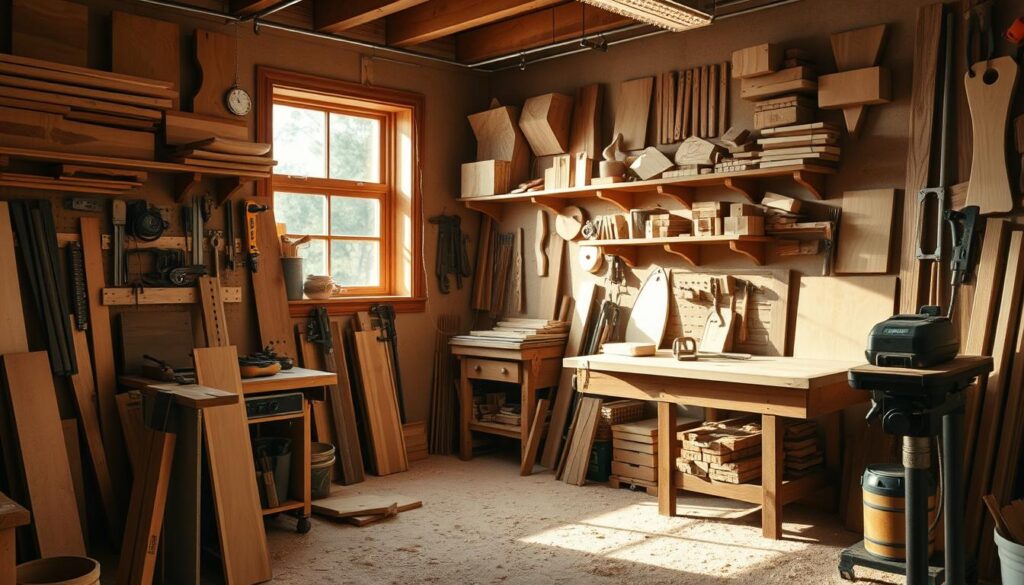
Tips for Improving Your Woodworking Skills
Starting your woodworking journey is exciting. But the real fun is in getting better at it. There are ways to improve your skills and make your projects even better.
Learning from Mistakes
Mistakes happen when you’re learning. But they’re also chances to get better. When something goes wrong, think about what you can do differently next time.
Woodworking takes practice. So, don’t get upset by mistakes. See them as steps towards getting better.
Joining Local Woodworking Groups
Meeting other woodworkers can really help. Look for local clubs, workshops, or groups. Being part of a community can give you lots of knowledge and support.
You can learn from others, share your own experiences, and work on projects together. It’s a great way to grow your skills.
Online Resources for Skill Development
- Check out online tutorials, forums, and blogs for tips on woodworking.
- Watch videos on YouTube to see how experts work and pick up new ideas.
- Take online courses or read e-books to learn more about specific skills or projects.
Improving at woodworking is a journey. Always look for ways to learn and try new things. With practice, support from others, and online resources, you can make amazing projects.
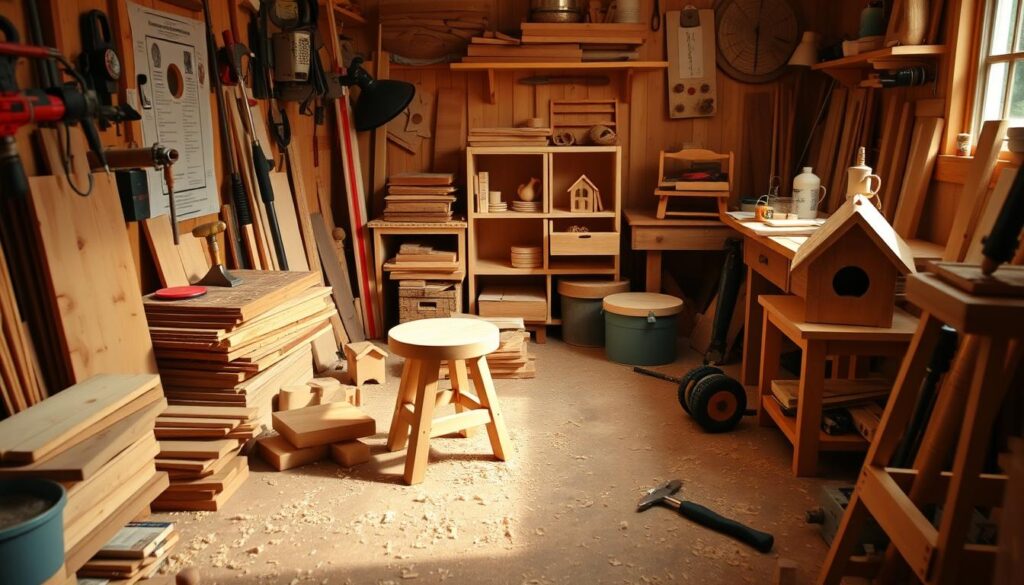
| Skill Development Strategies | Benefits |
|---|---|
| Learning from Mistakes | Gain insights, refine techniques, and build resilience |
| Joining Local Woodworking Groups | Access to knowledge, inspiration, and collaborative opportunities |
| Leveraging Online Resources | Comprehensive tutorials, forums, and skill-building courses |
The Role of Woodworking in Sustainable Living
Sustainability is key for today’s homeowners. DIY home decor and woodworking designs play a big part. Woodworkers can make beautiful pieces while being kind to the planet.
Benefits of Using Reclaimed Wood
Reclaimed wood is great for DIY fans and woodworkers. It’s unique and helps save our forests. It also cuts down on carbon emissions from lumber production.
Working with reclaimed wood is also more eco-friendly. It often needs less processing.
Eco-Friendly Practices in Woodworking
Woodworkers can do more to be green. Here are some ways:
- Plan cuts well to waste less
- Use non-toxic, water-based finishes
- Choose energy-efficient tools
- Buy wood locally or from FSC-certified sources
- Try using bamboo or cork
| Sustainable Woodworking Practices | Benefits |
|---|---|
| Using reclaimed wood | Reduces demand for new lumber, preserves forests |
| Minimizing waste | Conserves resources and reduces environmental impact |
| Choosing eco-friendly finishes and materials | Avoids harmful chemicals, promotes healthy homes |
By using these green methods, woodworkers can make stunning DIY home decor and woodworking designs. They help make our future more eco-friendly.
“Sustainable woodworking is not just about the end product – it’s about the entire process, from sourcing materials to creating lasting pieces that respect our environment.”
Conclusion and Next Steps
Exploring DIY woodworking has been a journey full of joy and growth. It’s about creating simple yet beautiful projects and embracing sustainable practices. This journey has helped me grow personally and express my creativity.
Embracing Your Woodworking Journey
The path ahead may have its ups and downs. But with each new skill and tool, you’ll get better and more confident. Enjoy every step, celebrate your wins, and keep looking for new things to learn.
Encouragement to Share Your Projects
Don’t be shy to show off your woodworking projects. Share them on social media, at craft fairs, or in workshops. Your work not only shows off your skills but also inspires and connects with others. It helps build a strong DIY woodworking community.
Resources for Ongoing Learning
There’s always more to learn in DIY woodworking. Look for online tutorials, join woodworking clubs, and read books and articles. Keep learning and exploring new things to do in DIY woodworking and woodworking plans. It’s exciting to keep growing and creating new things.


